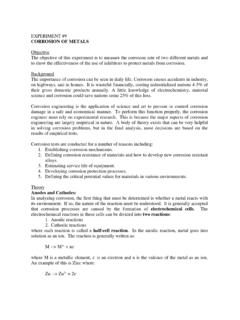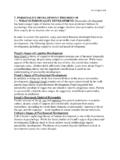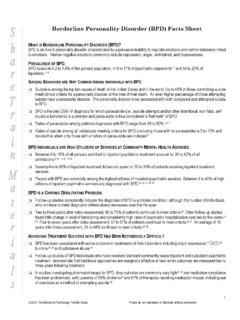Transcription of Dissociative and Somatoform Disorders
1 7. Dissociative and Somatoform Disorders CHAPTER. Jean Metzinger (1883 1956), "Woman, frontal and profile". 1917. Musee National d'Art Moderne. Centre National d'Art et de Culture. Georges Pompidou. Reunion des Musees Nationaux/Art Resource, NY. 2009 Artist Rights Society (ARS), NY. CHAPTER OUTLINE. Dissociative Disorders 212 227 Somatoform Disorders 227 241 Koro and Dhat Syndromes: Far Eastern Dissociative Identity Disorder Conversion Disorder Somatoform Disorders ? Dissociative Amnesia Hypochondriasis Theoretical Perspectives Dissociative Fugue Body Dysmorphic Disorder Treatment of Somatoform Disorders Depersonalization Disorder Pain Disorder SUMMING UP 241 242. Culture-Bound Dissociative Syndromes Somatization Disorder Theoretical Perspectives Treatment of Dissociative Disorders T R U T H or F I C T I O N. We Share a Single Body.
2 T F The term split personality refers to schizophrenia. (p. 214). Elaina is a licensed clinical therapist. Connie is a nurse. Sydney is a delightful little T F People who present with multiple girl who likes to collect bugs in an old mayonnaise jar. Lynn is shy and has trouble personalities generally show two or perhaps saying her l's, and Heather Heather is a teenager trying hard to be grown-up. We are three alternate personalities. (p. 215). many different people, but we have one very important thing in common: We share a T F Very few of us have episodes in single body.. which we feel strangely detached from our We have dozens of different people living inside us, each with our own memories, own bodies or thought processes. (p. 221). talents, dreams, and fears. Some of us come out to work or play or cook or sleep.
3 T F Most people who show multiple Some of us only watch from inside. Some of us are still lost in the past, a tortured past personalities do not report any history of full of incest and abuse. And there are many who were so damaged by this past and physical or sexual abuse during childhood. who have fled so deep inside, we fear we may never reach them.. (p. 224). Many of our Alter personalities were born of abuse. Some came because they were needed, others came to protect. T F Some people show up repeatedly at Leah came whenever she heard our father say, Come lay awhile with me. If she hospital emergency rooms, feigning illness came, none of our other Alters would have to do those things he wanted. She could do and seeking treatment for no apparent them for us, and protect us from that part of our childhood. reason.
4 (p. 230). Source: From Quiet Storm, a pseudonym used by a woman who claims to have several T F Some people who have lost their personalities residing within herself. ability to see or move their legs become strangely indifferent toward their physical condition. (p. 232). THIS IS A FIRST-HAND DESCRIPTION OF A PERSONALITY SO FRACTURED BECAUSE OF SEVERE T F In China in the 1980s, more than childhood abuse that it splinters into many different pieces. Some of the pieces bear 2,000 people fell prey to the belief that their genitals were shrinking and retracting into memories of the abuse, whereas others go about their business unaware of the pain their bodies. (p. 236). and trauma. Now imagine that these separate parts develop their own unique charac- teristics. Imagine too that these alter personalities become so compartmentalized that T F The term hysteria derives from the they don't know of each other's existence.
5 Even the core personality may not know of Greek word for testicle. (p. 237). the existence of the others. This is a description of Dissociative identity disorder, known popularly as multiple personality, perhaps the most perplexing and intriguing of all psychological Disorders . The diagnosis is officially recognized in the DSM system, although it remains controver- sial, with many professionals doubting its existence or ascribing it to a form of role- playing. Dissociative identity disorder is classified as a type of Dissociative disorder, a grouping of psychological Disorders characterized by changes or disturbances in the functions of self identity, memory, or consciousness that make the personality whole. Normally speaking, we know who we are. We may not be certain of ourselves in an existential, philosophical sense, but we know our names, where we live, and what we do for a living.
6 We also tend to remember the salient events of our lives. We may not recall every detail, and we may confuse what we had for dinner on Tuesday with what we had on Monday, but we generally know what we have been doing for the past days, weeks, and years. Normally speaking, there is a unity to consciousness that gives rise to a sense of self. We perceive ourselves as progressing through space and time. In people with Dissociative Disorders , one or more of these aspects of daily living is disturbed . sometimes bizarrely so. In this chapter we explore the Dissociative Disorders as well as another class of puz- zling Disorders , the Somatoform Disorders . People with Somatoform Disorders have physical complaints that defy any medical explanation and so are believed to involve underlying psychological conflicts or issues. People with these Disorders may report blindness or numbness, although no organic basis can be detected.
7 In other cases, people with Somatoform Disorders may hold exaggerated beliefs about the seriousness of their physical symptoms, such as taking them to be signs of life-threatening illnesses despite medical reassurances to the contrary. 211. 212 Chapter 7. In early versions of the DSM, Dissociative and Somatoform Disorders were classified with the anxiety Disorders under the general category of neurosis. This grouping was based on the psychodynamic model, which holds that Dissociative and Somatoform Disorders , as well as the anxiety Disorders discussed in Chapter 6, involve maladaptive ways of managing anxiety. In the anxiety Disorders , the appearance of disturbing levels of anxiety is expressed directly in behavior, such as in a phobic reaction to an object or situation. In contrast, the role of anxiety in the Dissociative and Somatoform Disorders is inferred rather than expressed overtly in behavior.
8 Persons with Dissociative disor- ders manifest psychological problems, such as loss of memory or changes in identity, that, according to the psychodynamic model, keep the underlying sources of anxiety out of awareness, such as conflicts over sexual or aggressive impulses. Likewise, people with some Somatoform Disorders often show a strange indifference to physical problems, such as loss of vision, that would greatly concern most of us. Here, too, it was theorized that the symptoms mask unconscious sources of anxiety. Some theorists interpret indifference to symptoms to mean that those symptoms have an underlying benefit;. that is, they help prevent anxiety from intruding into consciousness. The DSM now separates the anxiety Disorders from the other categories of neuroses . the Dissociative and Somatoform Disorders with which they were historically linked.
9 Yet many practitioners continue to use the broad conceptualization of neuroses as a useful framework for classifying the anxiety, Dissociative , and Somatoform Disorders . Dissociative Disorders . Dissociative disorder A disorder The major Dissociative Disorders include Dissociative identity disorder, Dissociative characterized by disruption, or dissociation, amnesia, Dissociative fugue, and depersonalization disorder. In each case, there is a of identity, memory, or consciousness. disruption or dissociation ( splitting off ) of the functions of identity, memory, or consciousness that normally make us whole. Table presents an overview of the Dissociative Disorders discussed in the text. Dissociative Identity Disorder The Ohio State campus dwelled in terror as four college women were seized, coerced to cash checks or get money from automatic teller machines, then raped.
10 A cryptic phone call led to the capture of Billy Milligan, a 23-year-old drifter who had been dishonorably discharged from the Navy. Not the Boy Next Door Billy wasn't quite the boy next door. He tried twice to commit suicide while he was awaiting trial, so his lawyers requested a psychiatric evaluation. The psy- chologists and psychiatrists who examined Billy deduced that ten personalities dwelled inside of him. Eight were male and two were female. Billy's personality had been fractured by a brutal childhood. The personalities displayed diverse facial expressions, memories, and vocal patterns. They performed in dissimilar ways on personality and intelligence tests. Arthur, a sensible but phlegmatic personality, conversed with a British accent. Danny, 14, was a painter of still lifes. Christopher, 13, was normal enough, but somewhat anxious.















